-
叉角厉蝽(Eocanthecona furcellata)属蝽科(Pentatomidae),分布范围广泛[1-4],是农林生产中一种重要的捕食性天敌,可以捕食多种害虫.据国内外研究报道,叉角厉蝽可以捕食Clostera fulgurita[5]、Corcyra cephalonica[6]、Maruca vitrata[7]、斜纹夜蛾(Spodoptera litura)和小菜蛾(Plutella xylostella)[8]、马尾松毛虫(Dendrolimus punctatus)[9]、香蕉弄蝶(Erionota torus)[10]等多种害虫. Nu等[11]研究发现,棉花上释放叉角厉蝽防治棉铃虫(Helicoverpa armigera),棉铃虫的为害减少了11.9%.蒋杰贤等[12]研究发现,在蔬菜田中释放叉角厉蝽可以有效控制斜纹夜蛾下一代的种群数量.
天敌的人工饲养,是天敌生物防治研究的重要基础之一,光周期是影响天敌繁育的重要因素之一.在自然界中,光周期属于一种比较稳定的环境因子,是影响昆虫生长发育、繁殖、生理代谢、行为节律及种群季节性变化的重要因素[13-14].时爱菊等[15]研究了光周期对大草蛉(Chrysopa pallens)的影响,结果表明,光周期对大草蛉2龄幼虫历期有比较明显的影响,幼虫期所处的光周期条件对预蛹的质量也有影响. Whittaker等[16]研究光周期对雌性苜蓿蓟马(Frankliniella occidentalis)行为的影响,发现光周期对雌性苜蓿蓟马的移动、取食量和产卵量都有影响,且雌性苜蓿蓟马的取食量由光照时间决定,取食量又决定了产卵速率.目前国内外对叉角厉蝽进行了包括生物学特性[8, 10]、人工饲养[17-18]、捕食作用[5-6]、对害虫的定位机制[19-20]等多方面的研究,而关于叉角厉蝽对光周期适应性的研究较少.本试验通过研究不同比例光周期条件下叉角厉蝽的生长及繁殖情况,测定其发育历期、寿命、繁殖力等生物学指标,明确其生长繁殖的最适光周期条件,为充分利用叉角厉蝽提供理论依据.
HTML
-
斜纹夜蛾来源于贵州大学昆虫研究所,用烟草饲养,连续饲养多代;叉角厉蝽由华南农业大学资源与环境学院提供,已经用斜纹夜蛾连续饲养多代.饲养条件:温度为(26±1) ℃,光周期为16L:8D,湿度为(70±7)%.
-
在不同的人工气候箱中(RZ-380A型,宁波江南仪器厂)分别设置24L:0D,16L:8D,14L:10D,12L:12D,10L:14D,8L:16D和0L:24D,共7个光周期处理.将初孵若虫挑至饲养盒(盒长17 cm,宽11.5 cm,高7 cm;盒盖有长10 cm,宽5 cm的方孔,方孔用纱网覆盖)中,进行单头饲养,将饲养盒置于不同光周期的人工气候箱中.叉角厉蝽在1龄时用蘸有10%蜂蜜水的棉花球进行饲养(1龄不捕食),待叉角厉蝽进入2龄后用斜纹夜蛾幼虫进行饲养,同时在盒内放置一个蘸湿清水的棉花球为叉角厉蝽提供水分.每天09:30和21:30点观察1次,记录叉角厉蝽各龄期若虫发育和死亡情况,羽化后记录成虫的羽化时间.每个处理观察30只若虫,重复5次.
-
挑取上述实验中相同光周期条件下羽化的正常无畸形的雌雄成虫各1头于饲养盒中,再将饲养盒置于对应的人工气候箱中.每天09:00点观察一次叉角厉蝽存活和产卵情况,收集叉角厉蝽产的卵块,并及时移除已死亡的成虫和被吸干的斜纹夜蛾幼虫,保持盒内清洁,给盒内添加食物和保持脱脂棉球湿润,实验直至所有的成虫死亡为止.将收集到的叉角厉蝽卵块计数和编号后置于相同环境条件参数的人工气候箱中,观察其孵化情况.每个处理各观察7对叉角厉蝽,3次重复.
-
所有数据先用Excel 2013进行整理,再用SPSS 21.0进行统计分析.叉角厉蝽发育历期、产卵前期、产卵量和雌雄成虫寿命用单因素方差分析进行差异显著性分析,并用Duncan's进行多重比较.若虫的存活率和卵孵化率先经过反正弦转换后再进行差异显著性分析.
1.1. 供试昆虫及饲养
1.2. 方法
1.2.1. 光周期对叉角厉蝽生长发育及存活率的影响
1.2.2. 光周期对叉角厉蝽成虫寿命及繁殖力的影响
1.3. 数据处理
-
由表 1可以看出,光周期对叉角厉蝽若虫发育历期有十分明显的影响.在24L:0D的光周期条件下若虫发育历期最短,为19.02 d,显著短于除16L:8D和14L:10D外的其他光周期处理.在24L:0D的光周期条件下,叉角厉蝽1~5龄若虫的发育历期最短,分别为2.80 d,3.83 d,3.23 d,3.21 d和5.04 d. 0L:24D的光周期条件下叉角厉蝽1~5龄若虫的发育历期最长,分别为3.21 d,4.67 d,4.11 d,4.85 d和6.73 d.试验结果可以看出,随着光照时间的增加,叉角厉蝽的各龄若虫的发育历期逐渐缩短.
-
从图 1可知,光周期对叉角厉蝽若虫存活率有一定的影响. 16L:8D光周期条件下,若虫存活率最高,为72.2%,显著高于除14L:10D外的其他光周期处理. 14L:10D光周期条件下的存活率为64.3%,要显著高于除16L:8D和12L:12D外的其他光周期处理. 10L:14D,24L:0D和8L:16D光周期条件的存活率分别为56.6%,54.2%和51.8%,相互之间差异不明显. 0L:24D光周期条件下叉角厉蝽若虫的存活率为47.2%,要显著低于除8L:16D和24L:0D外的其他处理.若虫的存活率随着光照时间的增加呈先增加后降低的趋势.
-
由图 2可知,光周期对叉角厉蝽的成虫寿命有显著的影响.光周期为16L:8D时雌、雄成虫寿命最长,分别为50.81 d和47.47 d,但与12L:12D和14L:10D处理之间没有显著差异.光周期为0L:24D时雌、雄成虫寿命最短,分别为30.67 d和35.71 d,其中雄成虫寿命要显著短于除8L:16D外的其他处理,雌成虫寿命显著短于其他处理. 24L:0D,10L:14D和8L:16D雌、雄成虫寿命之间均没有显著的差异.叉角厉蝽雌、雄成虫寿命随着光照时间的增加呈先延长后降低的趋势,说明在叉角厉蝽的饲养过程中适当增加光照时间有利于提高雌、雄成虫寿命.
-
图 3可知,光周期对叉角厉蝽的产卵前期有显著的影响.随着光照时间的增加,产卵前期逐渐缩短.当光周期为0L:24D时产卵前期最长,为14.48 d,要显著长于其他处理;当光周期为24L:0D时产卵前期最短,为8.35 d,显著短于除16L:8D和14L:10D外的其他光周期处理.虽然12L:12D条件下的产卵前期短于10L:14D和8L:16D,但3个处理产卵前期的差异没有统计学意义.
-
由图 4可知,光周期对产卵次数有显著的影响.在16L:8D的条件下产卵次数显著高于除14L:10D和12L:12D外的其他处理,为15.76次. 14L:10D和12L:12D条件下的产卵次数,分别为14.81次和14.62次.在0L:24D条件下产卵次数最低为8.86次,要显著低于其他处理.可以看出,叉角厉蝽产卵次数随着光照时间的增加而逐渐增加,但当光照时间增加至24 h时产卵次数又出现明显的下降,说明过高的光照时间也不利于叉角厉蝽产卵.
-
由图 5可知,光周期对产卵量有显著的影响.叉角厉蝽产卵量随着光照时间的增加呈先增加后降低的趋势.在16L:8D的条件下下产卵量最多,为663.1粒,14L:10D和12L:12D条件下的产卵量次之,分别为631.38粒和606.14粒,但3个处理之间差异没有统计学意义.在0L:24D条件下产卵量最低,为349.14粒,要显著低于其他处理.
-
由图 6可知,光周期对孵化率有显著的影响.在0L:24D的光周期处理下叉角厉蝽成虫所产的卵的孵化率显著低于其他处理,仅为62.08%;在光周期为16L:8D时其孵化率最高,为85.77%,但是与14L:10D和12L:12D处理之间的差异没有统计学意义.
2.1. 光周期对叉角厉蝽生长发育的影响
2.2. 光周期对叉角厉蝽若虫存活率的影响
2.3. 光周期对叉角厉蝽成虫寿命的影响
2.4. 光周期对叉角厉蝽成虫繁殖力的影响
2.4.1. 对产卵前期的影响
2.4.2. 对产卵次数的影响
2.4.3. 对产卵量的影响
2.4.4. 对后代孵化率的影响
-
光周期作为自然界中比较稳定的环境因子,光周期的变化与季节的变化密切相关,是昆虫预测季节变化的重要依据.本研究结果表明,光周期对叉角厉蝽生长发育及繁殖有明显的影响.在温度为(26±1) ℃、湿度为(70±7)%的条件下,本试验的光周期处理中,以16L:8D的光周期更有利于叉角厉蝽生长发育及繁殖,其若虫发育厉期(19.56 d)和存活率(72.2%)、雌成虫和雄成虫寿命(50.8 d,47.47 d)、产卵前期(9.48 d)、产卵次数(15.76次)、产卵量(663.1粒)和孵化率(85.77%)等各项指标均较好.
增加光照时间可以提高叉角厉蝽若虫发育速率、存活率和成虫寿命,但过长的光照时间会降低叉角厉蝽的存活率和成虫寿命,这与二点委夜蛾(Athetis lepigone)[21]、莲草直胸跳甲(Agasicles hygrophila)[22]和绿盲蝽(Apolyguslucorum)[23]的研究结果相似.但Reznik等[24]对异色瓢虫(Harmonia axyridis)的研究发现,20 ℃时短光照条件下有利于瓢虫幼虫发育,长光照条件下幼虫发育历期明显延长;马亚玲等[25]研究发现,豌豆蚜在短光照条件下的成虫寿命明显长于长光照条件下的成虫寿命.这与本研究研究结果不同,说明不同昆虫对光周期的需求也不尽相同.
Jian等[26]在温度为25 ℃和相对湿度60%的条件下,研究叉角厉蝽卵至成虫发育过程中分别处于不同光周期和相同光周期条件下的生长发育及繁殖情况,结果表明,增加光照时间可以缩短叉角厉蝽的产卵前期和提高产卵量.本试验发现,温度为26 ℃和相对湿度70%条件下,以12 h的光照时间为界,短光照条件下的产卵量明显少于长光照条件下的产卵量,且产卵前期也明显长于长光照条件下的产卵前期,这与Jian等[26]的研究结果相同.因此,在叉角厉蝽的饲养过程中适当增加光照时间有利于它的繁殖.
本试验是在温湿度恒定的条件下进行的,主要讨论并明确了光周期对叉角厉蝽生长发育及繁殖的影响趋势,并未考虑温度和湿度与光周期的联合作用,有待于今后进行更进一步的研究.

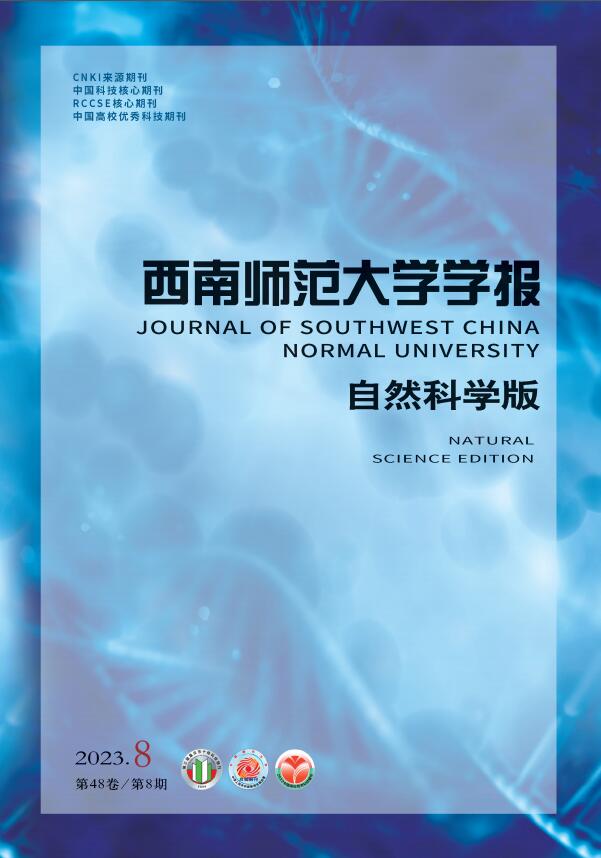


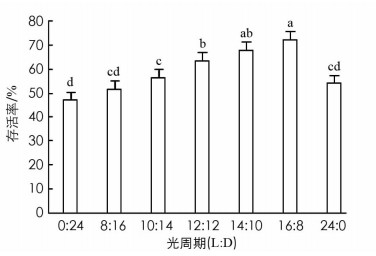


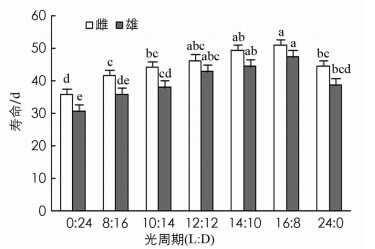
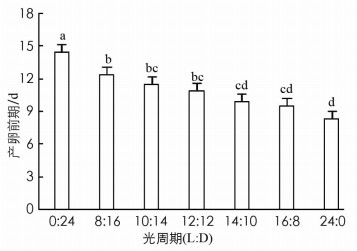
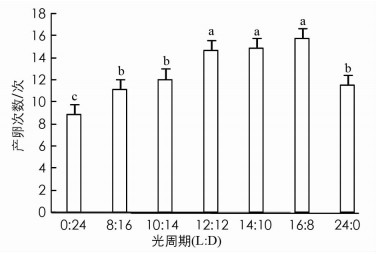
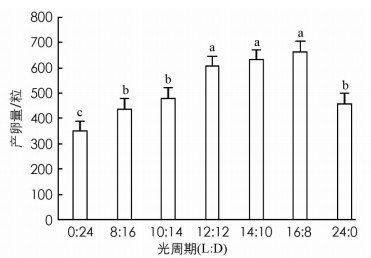
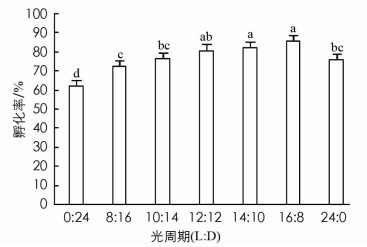
 DownLoad:
DownLoad: